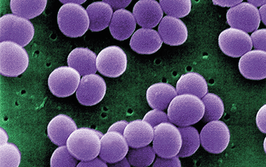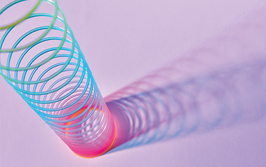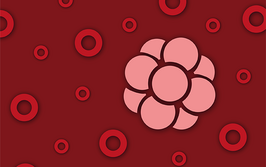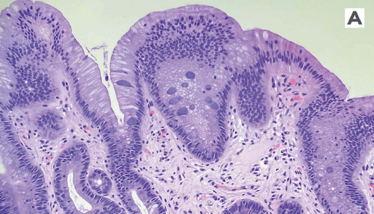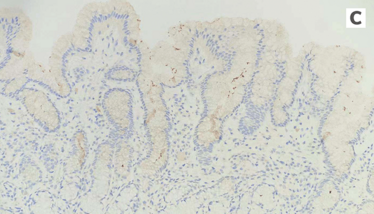Antral biopsy. A) Hematoxylin and eosin 40x; B) periodic Acid-Schiff-Alcian Blue 40x; C) positive immunochemistry for microorganism. Courtesy of Gang He
The changes in these images obtained from the antrum in a patient with chronic active gastritis are typically caused by Helicobacter pylori. Do biopsies with these metaplastic findings commonly stain positive for the associated microorganism?
a. Yes
b. No
Click here to register your guess.
Do you have an interesting case that you would like us to feature? Email it to [email protected].
Answer to March/April’s Case of the Month
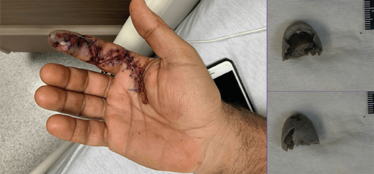
Figure 1. A) Initial surgical wound following the first debridement surgery; note the contrast between the injection site and the area of debridement. B,C) Amputated fingertip following subsequent surgical revision; note the dusky necrotic appearance of the fingertip.
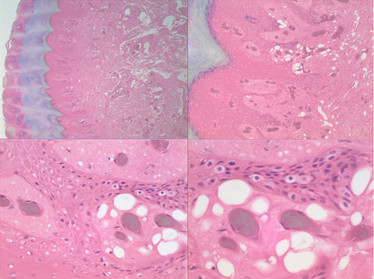
Figure 2. Microscopic images reflecting the extent of injury and the presence of foreign material in the interstitium and intravascular spaces. A) 4x; B) 10x; C) 20x; D) 40x.
C. Grease
Our patient presented with this puncture wound following a suspected injection injury from a hydraulic line the previous day. Representative sections of the fingertip showed necrosis of the epidermis, dermis, and subcutis (Figure 2A) and the presence of intravascular and interstitial foreign material (Figure 2B–D).
High-pressure injection injury is a medical emergency that must be addressed quickly to avoid extensive tissue damage. This type of injury is associated with deep infiltration of soft tissues; thus, debridement is required over a much larger area compared to the injury site, often requiring multiple revisions. Outcomes differ depending on the injected material; water generally has the best prognosis, whereas paint solvents usually require amputation (1,2,3,4). Injuries with hydraulic fluid and grease tend to cause less inflammatory response (5).
Though this type of injury is not uncommon, we present only the second case in literature that focuses on the histologic features (6).
Submitted by Rand Abou Shaar, Sameer Chhetri Aryal, and Jason Pimentel, Department of Pathology and Laboratory Medicine, Henry Ford Health System, Detroit, Michigan, USA
- MJ School et al., J Trauma, 20, 229 (1980). PMID: 6987411.
- ER Geller, E Gursel, J Trauma, 26, 483 (1986). PMID: 3701901.
- N Markal, S Celebioğlu, Ann Plast Surg, 44, 680 (2000). PMID: 10884095.
- CL Temple et al., Ann Plast Surg, 45, 64 (2000). PMID: 10917101.
- CJ Hogan, RT Ruland, J Orthop Trauma, 20, 503 (2006). PMID: 16891944.
- RA Dickson, Hand, 8, 189 (1976). PMID: 939447.

